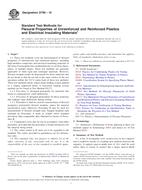Potrebujeme váš súhlas na využitie jednotlivých dát, aby sa vám okrem iného mohli ukazovať informácie týkajúce sa vašich záujmov. Súhlas udelíte kliknutím na tlačidlo „OK“.
ASTM D790-10
Standard Test Methods for Flexural Properties of Unreinforced and Reinforced Plastics and Electrical Insulating Materials
Automaticky preložený názov:
Štandardné skúšobné metódy pre ohybových vlastností z prostého a vystužených plastov a elektrických izolačných materiálov
NORMA vydaná dňa 1.4.2010
Informácie o norme:
Označenie normy: ASTM D790-10
Poznámka: NEPLATNÁ
Dátum vydania normy: 1.4.2010
Kód tovaru: NS-39261
Počet strán: 11
Približná hmotnosť: 33 g (0.07 libier)
Krajina: Americká technická norma
Kategória: Technické normy ASTM
Anotácia textu normy ASTM D790-10 :
Keywords:
flexural properties, plastics, stiffness, strength, Electrical insulating plastics, Flexural testing--electrical insulating materials, Flexural testing--plastics, Reinforced plastics, Stiffness--plastics, Unreinforced plastics, ICS Number Code 29.035.20 (Plastic and rubber insulating materials)
Doplňujúce informácie
| Significance and Use | ||||||||||||||||||||
|
Flexural properties as determined by these test methods are especially useful for quality control and specification purposes. Materials that do not fail by the maximum strain allowed under these test methods (3-point bend) may be more suited to a 4-point bend test. The basic difference between the two test methods is in the location of the maximum bending moment and maximum axial fiber stresses. The maximum axial fiber stresses occur on a line under the loading nose in 3-point bending and over the area between the loading noses in 4-point bending. Flexural properties may vary with specimen depth, temperature, atmospheric conditions, and the difference in rate of straining as specified in Procedures A and B (see also Note 7). Before proceeding with these test methods, reference should be made to the ASTM specification of the material being tested. Any test specimen preparation, conditioning, dimensions, or testing parameters, or combination thereof, covered in the ASTM material specification shall take precedence over those mentioned in these test methods. Table 1 in Classification System D4000 lists the ASTM material specifications that currently exist for plastics. |
||||||||||||||||||||
| 1. Scope | ||||||||||||||||||||
|
1.1 These test methods cover the determination of flexural properties of unreinforced and reinforced plastics, including high-modulus composites and electrical insulating materials in the form of rectangular bars molded directly or cut from sheets, plates, or molded shapes. These test methods are generally applicable to both rigid and semirigid materials. However, flexural strength cannot be determined for those materials that do not break or that do not fail in the outer surface of the test specimen within the 5.0 % strain limit of these test methods. These test methods utilize a three-point loading system applied to a simply supported beam. A four-point loading system method can be found in Test Method D6272. 1.1.1 Procedure A, designed principally for materials that break at comparatively small deflections. 1.1.2 Procedure B, designed particularly for those materials that undergo large deflections during testing. 1.1.3 Procedure A shall be used for measurement of flexural properties, particularly flexural modulus, unless the material specification states otherwise. Procedure B may be used for measurement of flexural strength only. Tangent modulus data obtained by Procedure A tends to exhibit lower standard deviations than comparable data obtained by means of Procedure B. 1.2 Comparative tests may be run in accordance with either procedure, provided that the procedure is found satisfactory for the material being tested. 1.3 The values stated in SI units are to be regarded as the standard. The values provided in parentheses are for information only. 1.4 This standard does not purport to address all of the safety concerns, if any, associated with its use. It is the responsibility of the user of this standard to establish appropriate safety and health practices and determine the applicability of regulatory limitations prior to use. Note 1—These test methods are not technically equivalent to ISO 178. |
||||||||||||||||||||
| 2. Referenced Documents | ||||||||||||||||||||
|
Odporúčame:
Aktualizácia technických noriem
Chcete mať istotu, že používate len platné technické normy?
Ponúkame Vám riešenie, ktoré Vám zaistí mesačný prehľad o aktuálnosti noriem, ktoré používate.
Chcete vedieť viac informácií ? Pozrite sa na túto stránku.




 Cookies
Cookies
